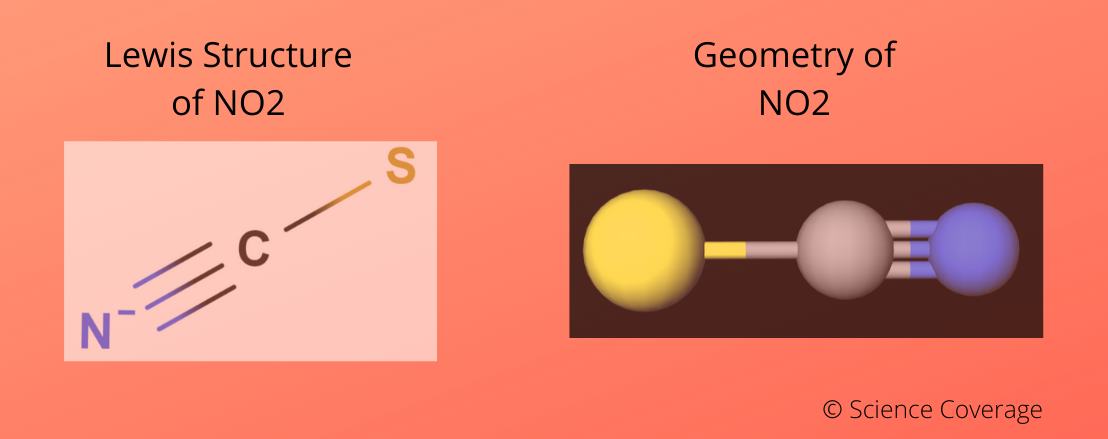SCN- is a polar molecule because of the electronegativity difference between nitrogen (3.04), sulfur (2.58), and carbon (2.55). Both Nitrogen and Sulphur attract the electrons from the Carbon atom, resulting in a partial positive charge on carbon and negative charges on nitrogen and sulfur.
Detailed Explanation: Why SCN- is a Polar molecule?
SCN- is the chemical formula of Thiocyanate which is also
known as Rhodanide and its IUPAC name is Cyanosulfanide. It is the conjugate
base of Thiocyanic acid and produced by the reaction of elemental sulfur with
cyanide.
Before going deep inside its polarity behavior, let’s have some basic ideas about polar and nonpolar molecules.
Polar Molecules
Those molecules having polar covalent bonds within the
molecule i.e. electronegativity difference between bonded atoms so that the formation of dipole charges on the molecules are known as polar molecules. The
net dipole moment shouldn’t be zero in the case of a polar molecule.
Polar molecules show little ionic characteristics as they
can conduct heat and electricity, can be soluble in water, and have a strong electrostatic force of attraction.
Examples of Polar molecules: Water (H2O), Nitrogen Dioxide (NO2), etc.
Nonpolar Molecules
Those molecules having the same electronegativity value for
bonded atoms so that there are not any formation partial positive and negative
charges within the molecule results in net dipole moment become zero are known
as nonpolar molecules. In many cases, there may exist polar bonds within the
molecules but whole molecules are considered as nonpolar due to the symmetrical
geometry of molecules which causes dipole charges of molecules to get canceled.
Nonpolar molecules are pure covalent bonds as they only show
covalent nature i.e. bad conductor of heat and electricity, insoluble in polar
solvents, etc.
Examples of Nonpolar molecules: Carbon Dioxide (CO2), Carbon
Tetrachloride (CCl4), Methane (CH4) etc.
Thiocyanate (SCN-) Polar or Nonpolar (On the basis of characteristics)
SCN- is a polar molecule and the Nitrogen atom closest to
negative side as the electronegativity of Nitrogen (3.04) is greater than Sulphur
(2.58) and Carbon (2.55). In this molecule, Nitrogen pulls the electrons from
both sulfur and carbon but E.N difference between Nitrogen and Sulphur is very
small so they can donate electrons within a reaction from either end of the
molecule.
These are some of the characteristics of SCN- which show why
it is considered as a polar molecule:
Electronegativity Difference
Electronegativity is the tendency of an atom to attract a shared pair of electrons within a molecule. Higher the E.N means the atom has a higher tendency to attract the lone pairs of electrons from a bonded partner.
According to the Pauli scale, the electronegativity difference of
two atoms is between 0.4 to 1.7, it is considered as polar bonding between the
atoms. In SCN,
E.N of Nitrogen= 3.04
E.N of Sulfur= 2.58
E.N of Carbon= 2.55
Here electronegativity difference between nitrogen and
carbon is 0.49 which causes the formation of a partial positive charge on the carbon atom
and partial negative charge on nitrogen i.e. bond is polar as a result molecule
is also polar.
Also Read: Is HCl Polar or Nonpolar Molecule?
Lewis Structure & Molecular Geometry
SCN- has a total of 16 valence electrons participated in molecule formation and there is not any lone pair of electrons on the central C atom. So, no electron-electron repulsion takes place inside the molecule.
Dipole Moment
The dipole moment is a product between the charge and distance
between the bonded atoms. It means higher the electronegativity difference
between the atoms higher the value of the net dipole moment, only if dipole charges
do not cancel each other. In SCN-, sulfur and nitrogen have higher
electronegativity value than carbon so that carbon atom has a partial positive
charge and the remaining atoms have partial negative charges induced.
Electron Density
Electron density is the possibility of electrons within the
molecule being present at a dedicated place. But due to the electronegativity
difference between the atom, atoms having higher E.N value pull electrons
towards themselves. Same in this SCN molecule, Sulfur, and Nitrogen having
higher E.N so that they attract electrons from the central Carbon atom.
Solubility Principle
According to the solubility principle “Like dissolves like”, SCN
is soluble in polar solvents like water, ammonia, most alcohols, hydrogen
fluoride, etc, and insoluble in nonpolar solvents like benzene, acetone, carbon
tetrachloride, etc (some exceptions always exist).
Sources of Thiocyanate (SCN-)
1. It is found in cigarette smoke and various plant foods like
cabbage, turnips, broccoli, and cauliflower.
2. In the human body, it is found in blood, feces, urine, and
saliva. It is also found inside the cell in mitochondria and cytoplasm.
3. Synthetically, it is formed by the reaction between cyanide
and S-S bonds compound in the presence of an aqueous medium.
Properties of SCN-
- It is soluble in water and most of the polar solvents.
- It shows an extremely strong acidic nature.
- Thiocyanate is considered a little toxic molecule due to its association with cyanide and thiosulfate.
Uses of Thiocyanate (SCN-)
- It is used in the treatment of hypertension in the emergency conditions.
- Its corresponding salts are used as herbicides and fungicides in the agrochemical industry.
- It is also very useful for hyperthyroid patients to regulate iodide transportation into the thyroid follicular cell.


Post a Comment